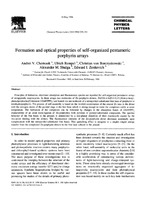Formation and optical properties of self-organized pentameric porphyrin arrays

Date
1996Bibliographic entry
Formation and optical properties of self-organized pentameric porphyrin arrays / A. V. Chernook [et al.] // Chemical Physics Letters. – 1996. – Vol. 254. – P. 229-241.
Abstract
Principles of formation, electronic absorption and fluorescence spectra are reported for self-organized pentameric arrays of tetrapyrrolic macrocycles. In these arrays two molecules of Zn-porphyrin dimers, Zn(II)l,4-bis[5-(10,15,20-tri-p-hexylphenylporphyrinyl)]-benzene ((ZnHTPP)₂) are bound via one molecule of a tetrapyridyl-substituted free base of porphyrin or tetrahydroporphyrin. The process of self-assembly is based on the twofold coordination of the central Zn ions !n the dimer with the nitrogen atoms of the pyridyl rings in the free base which is strong enough to make the complexes stable at room temperature. The formation of the complexes can be followed by changes in the absorption bands of (ZnHTPP)₂ characteristic of an axial extra-ligation of Zn-porphyrins with pyridine or pyridyl-substituted compounds. The spectral behavior of the free bases in the pentads is determined by a non-planar distortion of their macrocycle caused by the two-point binding with the dimers. The fluorescence intensity of the Zn-porphyrin dimer decreases essentially upon complexation with the tetrapyridyl-substituted free bases. This quenching effect is assigned to a singlet-silaglet energy transfer from the complexed Zn-porphyrin dimers to the free base subunit in the pentad.
